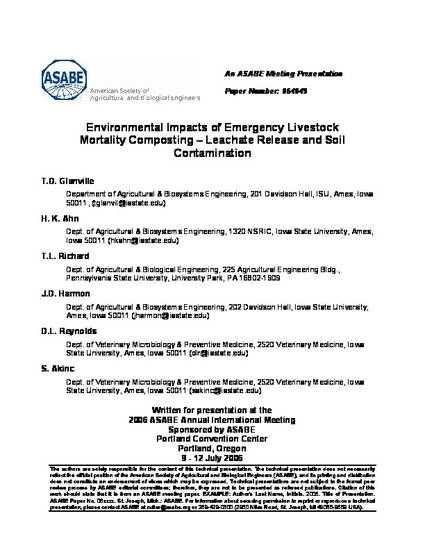
Article
Environmental Impacts of Emergency Livestock Mortality Composting—Leachate Release and Soil Contamination
Agricultural and Biosystems Engineering Conference Proceedings and Presentations
Document Type
Conference Proceeding
Disciplines
Conference
2006 ASABE Annual International Meeting
Publication Date
7-1-2006
Geolocation
(45.5234515, -122.6762071)
Abstract
A 3-year study was conducted in Iowa to evaluate the feasibility of using composting for emergency disposal of cattle mortalities. During the study, 49 metric tons of 450 kg cattle carcasses were composted in 27 replicated unturned windrow test units constructed during three different seasons of the year. Each test unit contained 1.8 metric tons of carcasses enveloped in one of 5 different materials: corn silage, ground cornstalks, straw/manure, leaves, or a soil/compost blend. Due to their water absorbing capacity and ability to evaporate absorbed water, the volume of leachate released into the soil was generally less than 5% of the 500-600 mm of precipitation that fell on the test units. Chemical analysis of 1.2 m deep soil cores collected from beneath the composting test units prior to and following composting showed statistically significant increases in chloride concentrations at all depths beneath composting test units constructed from silage, cornstalks, straw, and the soil/compost blend. Statistically significant increases in % total carbon (silage test units only) and % total nitrogen (silage, cornstalk, straw/manure test units) were limited to the top 15 cm of soil. Increases in these pollutants were moderate, amounting to less than 5X, 0.2X and 0.4 X respectively of chloride, % total carbon, % total N concentrations prior to composting. Statistically significant increases in total ammonia-nitrogen were noted at depths of up to 90 cm beneath test units constructed with silage or leaves, and at 30 cm and 15 cm depths respectively beneath test units constructed with straw/manure and cornstalks. The ammonia-nitrogen increases were large, ranging from 40-160 X of pre-composting levels of ammonia in the topsoil. When compared with the groundwater pollution potential of carcass burial, however, the estimated total mass of N contained in the composted cattle carcasses was 4-10 X the increases in total N measured in the soil beneath the composting test units.
Copyright Owner
American Society of Agricultural Engineers
Copyright Date
2006
Language
en
Citation Information
Thomas D. Glanville, Heekwon Ahn, Thomas L. Richard, Jay D. Harmon, et al.. "Environmental Impacts of Emergency Livestock Mortality Composting—Leachate Release and Soil Contamination" Portland, OR(2006) Available at: http://works.bepress.com/thomas_glanville/33/

This is an ASAE Meeting Presentation, Paper No. 064049.